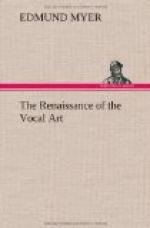Every tone sung, as we have learned, is a reinforced sound. There are two ways of reinforcing tone. First, by muscular tension, muscular contraction, muscular effort—the wrong way. Second, by vitalized energy, by expansion, and by added resonance of air in the inflated cavities—the right way. Of course to produce expansion and inflation, true conditions of form and adjustment must prevail, through the movements given.
Form has much to do with determining the quality and character of the tone. Muscular effort, either in placing or reinforcing the tone, results in muscular contraction, and in most cases in elliptical form of voice, thus: [drawn horizontal oval] This means depressed soft palate, high larynx, contraction of the fauces, closed throat, and spread open mouth. Result—high placing impossible, no low color or reinforcement; in short, hard muscular tone. The tone may be loud but it cannot be musical.
The true musical form of the voice is elongation, thus: [drawn vertical oval] This means high placing and low resonance; it means that the tone has the ring of forward high placing and the reinforcement, color, and beauty of added low resonance. Elongation is a distinguishing feature of all truly great voices.
For artistic tone, the soft palate must be high, the larynx must be low, and the throat and mouth allowed to form, not made or compelled. The form must be flexible and elastic. The larynx must be low in adjustment for the production of beautiful tone, but it must never be locally adjusted. It must always be influenced indirectly through the movements we advocate, through the true position and action of singing. In this way are secured open throat, freedom of voice, all true conditions. In this way the tone may be placed by impulse, by flexible action, may be started high and instantly reflected into the inflated cavities. This means perfect poise of voice; it means the focus of the tone high and forward with the sympathetic added vibration of the low cavities and especially of the chest. This is the only true placing of voice,—the combination of head and chest resonance through automatic form and adjustment. A tight throat through local, muscular effort makes these conditions impossible.
The true resonance-chamber then, as we have found, is from head to chest; sympathetically the resonance of the entire body must be added. The true artist sings with the body, through the throat, and never with the throat. In this way the entire singer is the instrument. Fill the body with sound. The higher the tone the more elongated the form. Nature demands this. If this does not occur contraction and depression are sure to follow. Also the higher the tone the lower the added resonance, when the conditions are right. In this way the form elongates and the compass expands without effort or strain. These ideas studied through flexible movements are truly wonderful, but natural means for expanding the compass of the voice.




